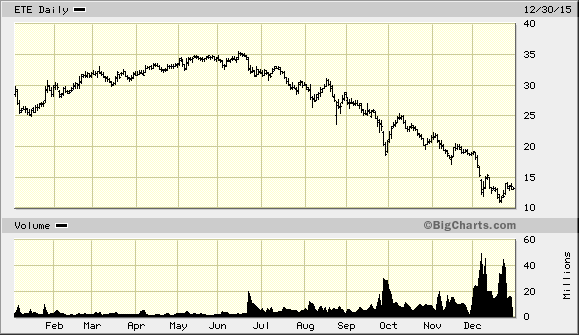This piece first appeared on InvestorPlace as part of its Best Stocks for 2016 contest. There are several excellent picks this year, and the competition promises to be fierce!
If you’ve read my work for any length of time, you know I’m not a major risk taker. In my experience, slow and steady wins the race.
That was my rationale for recommending Prospect Capital (PSEC) in last year’s Best Stocks contest. I reasoned that a diversified private equity portfolio trading at a deep discount to book value was a low-risk investment with a high probability of generating a market-beating return. Between a return to book value and the high dividend, I expected total returns of as high as 40% within 12 to 18 months.
Well, we didn’t quite get there, or at least not yet. The value investor’s eternal problem is that a cheap stock can stay cheap for a lot longer than you expect. But at least we were paid handsomely to wait with PSEC’s dividend.
This year, I’m recommending another beaten-down value stock with a high dividend (technically a “distribution” in this case), MLP general partner Energy Transfer Equity (ETE).
A look at Energy Transfer Equity’s stock chart will give you heartburn. Serious heartburn. ETE shares lost more than half their value between July and December, as the entire midstream MLP space got hammered. But at today’s prices, Energy Transfer Equity gives us exposure to one of the world’s premier energy transportation company at prices I do not expect to see again in our lifetimes. Furthermore, I believe that much of the drop we saw in December was due to indiscriminate selling by investors fleeing the entire sector rather than due ETE’s prospects.

Background
Energy Transfer Equity is an MLP, but it’s a peculiar kind in that, rather than own pipeline interests itself, its primary role is to serve as a general partner to a collection of other MLPs. In this sense, ETE has a lot more in common with Kinder Morgan (KMI) before its reorganization late in 2014 than it does with most other “traditional” MLPs.
You can explain Energy Transfer’s company structure with two words: “It’s complicated.” Energy Transfer Equity is the head of a sprawling energy empire consisting of six companies that are currently traded today: Energy Transfer Equity, Energy Transfer Partners (ETP), Williams Partners (WPZ), Sunoco LP (SUN), Sunoco Logistics Partners LP (SXL), and Williams Companies (WMB), which is not shown in the chart below because it is in the process of being rolled into ETE. A final entity — Energy Transfer Corp (ETC) — is to be formed in 2016 and will be similar in structure to other corporations operating in the midstream MLP space, such as Kinder Morgan and OneOk (OKE).
Taken together, the consolidated Energy Transfer empire will has bigger network of pipelines that either Kinder Morgan or Enterprise Products Partners (EPD), at 104,000 miles. It’s the largest transporter of natural gas in the U.S. (moving 35% of all natural gas in America), the third-largest natural gas liquids business, the third-largest MLP crude oil transporter, and has the second-largest liquefied natural gas export facility planned. Quite simply, Energy Transfer is the proverbial 800-pound gorilla in the midstream energy space.
Looking at ETE Stock
When I evaluate a stock, I like to have four basic criteria in place:
- The stock should be on the right side of a durable macro trend.
- The stock should be cheap.
- The stock should be shareholder friendly.
- Management should have “skin in the game” in the form of insider ownership and buying.
Not every stock I buy will have all four criteria in place, but ETE most certainly does.
I’ll start with the most controversial point: That ETE is on the right side of a durable macro trend. That might sound like an odd thing to say given that crude oil prices are in free fall and the entire energy industry is in a state of crisis right now. While ETE has virtually no direct exposure to falling crude oil prices, some of its subsidiaries have at least indirect exposure in that a prolonged depression in energy prices would affect domestic energy production and the volume of oil and gas flowing through their pipelines.
I consider this exposure manageable. Meanwhile, I still consider U.S. natural gas exportation to be one of the major macro themes of the years ahead, as importers look to lessen their dependence on Russia and the volatile Middle East. (I’m not alone in this belief. Consider Seth Klarman and Carl Icahn’s massive investments in Cheniere Energy (LNG), which I highlighted here.)
Moving on, let’s look at value. After losing more than half its value, value investors are bound to start sniffing around ETE. But are the shares truly cheap at these prices?
Yes. I start with the distribution yield, which at 9.6%, is about as high as its ever been in the company’s history. Yes, as we saw with Kinder Morgan, even sacrosanct dividends can be cut. But in ETE’s case, the underlying MLPs fueling the distribution are a lot less levered and thus at less risk of a cut. As an example, Energy Transfer Partners is leveraged about 4.75 times (debt/EBITDA). Kinder Morgan is leveraged over 6 times, though it is in the process of deleveraging itself.
As of last quarter, ETE’s distribution coverage ratio was 1.09. ETP’s coverage ratio was lower last quarter, at just 0.97 for the first nine months of the year. Yet management was confident enough that cash flows will improve in 2016 that they raised the distribution by 2 cents per share last quarter.
Using the trailing four quarters of distributable cash flow (“DCF”), ETE trades at a price/DCF ratio of 9.9. That is remarkably cheap for any MLP, particularly a general partner growing its distribution at a rapid clip.
That brings me to my next criteria: Shareholder friendliness. ETE has been an absolute monster when it comes to raising its cash payout.
Over the past year, ETE has raised its dividend by a full third, and it’s more than doubled its payout since 2011.
In a recent CNBC appearance, CFO Jamie Welch hinted that distribution growth might slow a little in 2016, owing to the company’s desire to keep leverage under control in this credit environment. ETE doesn’t want to be “the next Kinder Morgan” and be forced to cut its payout later. (I recommend you watch Welch’s interview. It’s gives a decent bit of insight into ETE’s prospects over the coming years.) But Welch makes it clear that ETE will still have “significant” distribution growth in 2016.
We’ll see about that growth. Energy Transfer might decide to play it safe, hoard cash, and keep its payout constant. But even with zero distribution growth in 2016, you’re looking at fantastic potential total returns.
And finally, we come to insider activity. ETE’s executives have a massive amount of skin in the game. Company founder Kelcy Warren dropped over $41 million of his own money into the stock in early December. This is after he already dropped $63 million in July, $19 million in January… and $80 million last fall.
That’s about $200 million in insider buying by just one man. Yes, Warren is a billionaire. Forbes pegs his net worth at $3.2 billion. But that still shows major commitment from one of the smartest men in the energy industry.
What kind of returns do I expect for Energy Transfer Equity in 2016?
Starting at today’s prices, I would say returns of 50%-100% in 12-24 months is possible.
So, what are the risks?
Alas, there are no free lunches in this business. The entire MLP space is currently under attack, and as we saw with Kinder Morgan, bad things happen when the credit markets turn negative on a company. Should Wall Street decide that the entire MLP model needs to be scrapped, and all existing MLPs need to deleverage, then ETE will get hit along with the rest of the sector.
That said, at today’s prices, there is a lot of fear already priced in. ETE is a steal, and I expect it to trounce the competition in InvestorPlace’s contest this year.
Disclosure: Long ETE, EPD, KMI, OKE
Charles Lewis Sizemore, CFA, is chief investment officer of the investment firm Sizemore Capital Management and the author of the Sizemore Insights blog.



Thank you for this analysis. I sent you a private note but I should have posted my question here: What do you think the relative value of WMB is compared to ETE? Receiving $8 cash plus 1.5274 shares of ETC seems attractive to me. Thank you for your consideration.
David A Booth
long WMB, ETE, KMI
[…] By Charles Sizemore, Sizemore Capital Management […]
Charles, just wanted to stop by and revisit this post from the end of last year. I agreed with you ETE was attractive, but when it hit 12 I loved it. When it hit 8 I bought a bunch. When it went to 4, I sold every holding I own and put it in ETE. Lots of money that I manage for relatives, as well. Sitting here at over 18 today, I’m sure you’re a happy man, and as you can imagine I am, too. As hectic as things get in our business, it’s nice, just every once in a while, to sit back and bask in the glow of an opportunity like that. Cheers.
Joe Filberto
Chief Investment Officer
Cross Staff Investments
Long ETE with no end in sight
Thank you, sir! Yes, ETE was not fun to own back in January. But I agree, I see no end in sight. I think this will be a $50 stock in two years.
Have a great week,
Charles
Thank you, sir! Yes, ETE was not fun to own back in January. But I agree, I see no end in sight. I think this will be a $50 stock in two years.
Have a great week,
Charles